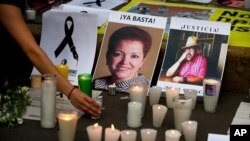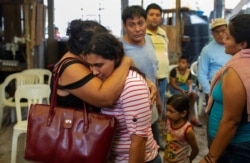Mexican voters will go to the polls Sunday to elect candidates for thousands of local offices, and in a country where elections have a tradition of violence, journalists will be in the crosshairs.
“We know that when there's so much violence, journalists who cover these elections, they can become targets, too,” said Jan-Albert Hootsen, the Mexico representative at the Committee to Protect Journalists (CPJ).
In April, the U.S.-based rights group went so far as to publish a “journalists safety kit” just for the Mexico elections, citing harassment, online bullying and assassination. Five journalists were killed in 2020; one was shot and killed in May, and another survived a knife attack.
Mexico emerged as one of the world’s most dangerous countries for journalists, along with Syria, in 2019 and has remained among the least safe countries to report in ever since. CPJ counts 15 missing journalists since 2006 and at least 10 slain journalists in the past three years.
“In Mexico, journalists, especially those who cover crime, corruption, abuses of power by the authorities and drug trafficking, tend to be extremely vulnerable to [threatening] texts specifically from criminal gangs, but also from politicians who may be involved with those criminal gangs,” Hootsen said. “And this is a phenomenon that we see across the country.”
'Constant war'
In the knife incident, journalist Luis Raul Aguilar Perez was gravely injured May 21 in his home state of Guanajuato, where he covers local politics. He told CPJ that an assailant might have been trying to slit his throat. Aguilar Perez was seriously wounded on his neck and hands.
“Covering the Mexican administration is like being in a constant war of defending freedom of expression while taking on the costs, which include attacks on your life, digital attacks that leave the media without tools to work, intimidation or even the risk of losing one’s life,” he told VOA.
Aguilar Perez is the founder and editor of Penjamo.biz, which earlier in May published information about a criminal lawsuit involving one local politician.
“At this time, the causes of the attack are speculated to be that it was due to personal overtones or because of the activities I carry out in the media. In either case, it is difficult in Mexico to clarify facts like these,” Aguilar Perez said.
Very few arrested, convicted
The risk of violence is pervasive across Mexico. Seldom is anyone held accountable.
“The impunity rate in crimes against the press is above 90%, meaning that less than 10% of the people who commit crimes against the press are actually arrested and convicted,” said Hootsen. “With an impunity rating this high, it means that anyone who wants to hurt a journalist, who wants to commit one of those crimes, has a very powerful incentive.”
Online violence aimed at journalists has been rising for several years. In 2017, the nonprofit Citizen Lab reported that the Mexican government had targeted 10 Mexican journalists and human rights defenders from January 2015 to August 2016.
The journalists had all been involved in investigating or working on reports of high-level official corruption, or government involvement in human rights abuses. Targets received text messages with personal and sexual taunts and kidnapping warnings, among other threats.
More recently, on March 23, 2021, in the state of Baja California, investigative reporter Dianeth Perez Arreola received a letter from a special prosecutor for electoral crimes.
The letter ordered her to remove online content with references to a female political candidate and warned Perez Arreola not to publish details about the candidate that “denigrate or degrade a woman.”
'Absurd' allegations
Perez Arreola had published a video alleging that the candidate used her position in the Sonora governor’s office to enrich herself. Perez Arreola faces arrest or fines if she refuses to comply with the letter, according to an account by CPJ.
“The allegations are absurd, as none of the videos were about [the candidate’s] personal life, and none of them contained any content that would be degrading to her as a woman,” Perez Arreola said to CPJ.
Given the gang violence and government corruption in Mexico, journalists often don’t know where threats are coming from. That makes it hard to take precautions.
“Even if measures are taken to stay safe, they are an illusion. When someone is a clear target, there is no army to protect anyone,” said Aguilar Perez.
Still, Hootsen said journalists can create their own mutual safety net.
“When reporting on the election, try to check in with your colleagues. Try to make sure that people know where you are, what you're doing, and make sure that you know who to call when you get into trouble,” Hootsen said.
Despite the risks, Aguilar Perez takes solace in the belief that Mexicans still respect and respond to journalism that holds politicians accountable for their actions.
“The only thing that still weighs on Mexican politics is the public claim of citizens,” he said. “In my case, the support of citizens and fellow media has been the most important factor.”





